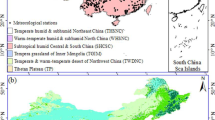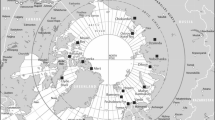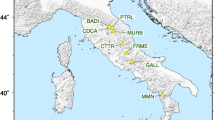Abstract
Temporal shifts in phenology or vegetation period of plants are seen as indicators of global warming with potentially severe impacts on ecosystem functioning. In spite of increasing knowledge on drivers, it is of utmost importance to disentangle the relationship between air temperatures, phenological events, potential temporal lags (phase shifts) and time scale for certain plant species. Assessing the phase shifts as well as the scale-dependent relationship between temperature and vegetation phenology requires the development of a nonlinear temporal model. Therefore, we use wavelet analysis and present a framework for identifying scale-dependent cross-phase coupling of bivariate time series. It allows the calculation of (a) scale-dependent decompositions of time series, (b) phase shifts of seasonal components in relation to the annual cycle, and (c) inter-annual phase differences between seasonal phases of different time series. The model is applied to air temperature data and remote sensing phenology data of a beech forest in Germany. Our study reveals that certain seasonal changes in amplitude and phase with respect to the normal annual rhythm of temperature and beech phenology are coupled time-delayed components, which are characterized by a time shift of about one year.




Similar content being viewed by others
References
Aguiar-Conraria A, Azevedo N, Soares M (2008) Using wavelets to decompose the time–frequency effects of monetary policy. Phys A 387:2863–2878
Allefeld C, Kurths J (2004) Testing for phase synchronization. Int J Bifurcat Chaos 14:405–416
Badeck F, Bondeau A, Böttcher K, Doktor D, Lucht W, Schaber J, Sitch S (2004) Responses of spring phenology to climate change. New Phytol 162:295–309
Barbaroux C, Bréda N (2002) Contrasting distribution and seasonal dynamics of carbohydrate reserves in stem wood of adult ring-porous sessile oak and diffuse-porous beech trees. Tree Physiol 22:1201–1210
Bunn A (2008) A dendrochronology program library in R (dplR). Dendrochronologia 26:115–124
Campioli M, Gielen B, Göckede M, Papale D, Bouriaud O, Granier A (2011) Temporal variability of the NPP–GPP ratio at seasonal and interannual time scales in a temperate beech forest. Biogeosciences 8:2481–2492
Cazelles B, Stone L (2003) Detection of imperfect population synchrony in an uncertain world. J Anim Ecol 72:953–968
Cazelles B, Chavez M, McMichael A, Hales S (2005) Nonstationary influence of El Niño on the synchronous dengue epidemics in Thailand. PLoS Med 2:313–318
Cazelles B, Chavez M, Berteaux D, Ménard F, Vik J, Jenouvrier S, Stenseth N (2008) Wavelet analysis of ecological time series. Oecologia 156:287–304
Chmielewski F, Rötzer T (2001) Response of tree phenology to climate change across Europe. Agric For Meteorol 108:101–112
Cleland E, Chuine I, Menzel A, Mooney H, Schwartz M (2007) Shifting plant phenology in response to global change. Trends Ecol Evol 22:357–365
Čufar K, Prislan P, de Luis M, Gričar J (2008) Tree-ring variation, wood formation and phenology of beech (Fagus sylvatica) from a representative site in Slovenia, SE Central Europe. Trees 22:749–758
Delbart N, Picard G, Le Toan T, Kergoat L, Quegan S, Woodward I, Fedotova V (2008) Spring phenology in boreal Eurasia over a nearly century time scale. Glob Change Biol 14:603–614
Doktor D, Bondeau A, Koslowski D, Badeck F (2009) Influence of heterogeneous landscapes on computed green-up dates based on daily AVHRR NDVI observations. Remote Sens Environ 113:2618–2632
Foufoula-Georgiou E, Kumar P (1997) Wavelet analysis for geophysical applications. Rev Geophys 35(4):385–412
Gough CM, Flower CE, Vogel CS, Curtis PS (2010) Phenological and temperature controls on the temporal non-structural carbohydrate dynamics of Populus grandidentata and Quercus rubra. Forests 1:65–81
Goward S, Huemmrich K (1992) Vegetation canopy PAR absorptance and the normalized difference vegetation index: an assessment using the SAIL model. Remote Sens Environ 39:119–140
Grenfell B, Bjørnstad O, Kappey J (2001) Travelling waves and spatial hierarchies in measles epidemics. Nature 414:716–723
Hudson I (2010) Interdisciplinary approaches: towards new statistical methods for phenological studies. Clim Change 100:143–171
Hudson I, Keatley MR, Kang I (2011) Wavelet characterization of eucalypt flowering and the influence of climate. Environ Ecol Stat 18:513–533
Klvana I, Berteaux D, Cazelles B (2004) Porcupine feeding scars and climatic data show ecosystem effects of the solar cycle. Am Nat 164:283–297
Lachaux JP, Rodriguez E, le van Quyen M, Lutz A, Martinerie J, Varela F (2000) Studying single-trials of phase synchronous activity in the brain. Int J Bifurcat Chaos 10:2429–2439
Lu P, Yu Q, Liu J, He Q (2006) Effects of changes in spring temperature on flowering dates of woody plants across China. Bot Stud 47:153–161
Mariappan N (2010) Net primary productivity estimation of Eastern Ghats using multispectral MODIS data. Int J Geomat Geosci 1:406–413
Menzel A (2000) Trends in phenological phases in Europe between 1951 and 1996. Int J Biometeorol 44:76–81
Menzel A (2003) Plant phenological anomalies in Germany and their relation to air temperature and NAO. Clim Change 57:243–263
Menzel A, Sparks T, Estrella N, Roy D (2006) Altered geographic and temporal variability in phenology in response to climate change. Glob Ecol Biogeogr 15:498–504
Miller-Rushing A, Inouye D, Primack R (2008) How well do first flowering dates measure plant responses to climate change? The effects of population size and sampling frequency. J Ecol 96:1289–1296
Paluš M, Novotná D (2006) Quasi-biennial oscillations extracted from the monthly NAO index and temperature records are phase-synchronized. Nonlin Process Geophys 13:287–296
Paluš M, Novotná D (2011) Northern hemisphere patterns of phase coherence between solar/geomagmetic activity and NCEP/NCAR and ERA40 near-surface air temperature in period 7–8 y oscillatorymodes. Nonlin Process Geophys 18:251–260
Paluš M, Novotná D, Tichavský P (2005) Shifts of seasons at the European mid-latitudes: natural fluctuations correlated with the North Atlantic oscillation. Geophys Res Lett 32:L12805
Parmesan C (2007) Influences of species, latitudes and methodologies on estimates of phenological response to global warming. Glob Change Biol 13:1860–1872
Percival D, Walden A (2000) Wavelet methods for time series analysis. Cambridge University Press, Cambridge
Percival D, Wang M, Overland J (2004) An introduction to wavelet analysis with applications to vegetation time series. Community Ecol 5:19–30
Pikovsky A, Rosenblum M, Kurths J (2001) Synchronization, a universal concept in nonlinear sciences. Cambridge University Press, Cambridge
Post E, Pedersen C, Wilmers C, Forchhammer M (2008) Phenological sequences reveal aggregate life history response to climatic warming. Ecology 89:363–370
Sjöström M, Ardö J, Arneth A, Boulain N, Cappelaere B, Eklundh L, Veenendaal E (2011) Exploring the potential of MODIS EVI for modeling gross primary production across African ecosystems. Remote Sens Environ 115:1081–1089
Skomarkova MV, Vaganov EA, Mund M, Knohl A, Linke P, Boerner A, Schulze ED (2006) Inter-annual and seasonal variability of radial growth, wood density and carbon isotope ratios in tree rings of beech (Fagus sylvatica) growing in Germany and Italy. Trees 20:571–586
Sparks T, Jeffree E, Jeffree C (2000) An examination of the relationship between flowering times and temperature at the national scale using long-term phenological records from the UK. Int J Biometeorol 44:82–87
R Development Core Team (2010) R: a language and environment for statistical computing. R Foundation for Statistical Computing, Vienna. ISBN 3-900051-07-0. http://www.R-project.org}
Torrence C, Compo G (1998) A practical guide to wavelet analysis. Bull Am Meteorol Soc 79:61–78
Torrence C, Webster P (1999) Interdecadal changes in the ENSO–monsoon system. J Clim 12:2679–2690
Wareing P (1953) Growth studies in woody species V. Photoperiodism in dormant buds of Fagus sylvatica L. Physiol Plant 6:692–706. doi:10.1111/j.1399-3054.1953.tb08442.x
White M, Brunsell N, Schwartz M (2003) Vegetation phenology in global change studies. In: Schwartz M (ed) Phenology: an integrative environmental science. Kluwer Academic Publishers, Dordrecht, pp 453–466
Yang T, Xu C, Shao Q, Chen X, Lu G, Hao Z (2010) Temporal and spatial patterns of low-flow changes in the Yellow River in the last half century. Stoch Environ Res Risk Assess 24:297–309
Yang Y, Xu J, Hong Y, Lv G (2012) The dynamic of vegetation coverage and its response to climate factors in Inner Mongolia, China. Stoch Environ Res Risk Assess 26:357–373
Zhang Q, Xu C, Chen Y (2010) Wavelet-based characterization of water level behaviors in the Pearl River estuary, China. Stoch Environ Res Risk Assess 24:81–92
Acknowledgments
We acknowledge support by the EU infrastructure project “Distributed Infrastructure for EXPErimentation in Ecosystem Research—EXPEER” (project reference 262060) funded under 7th Framework Programme. We would also like to thank Maximilian Lange (UFZ) who provided assistance with data assimilation.
Author information
Authors and Affiliations
Corresponding author
Rights and permissions
About this article
Cite this article
Carl, G., Doktor, D., Koslowsky, D. et al. Phase difference analysis of temperature and vegetation phenology for beech forest: a wavelet approach. Stoch Environ Res Risk Assess 27, 1221–1230 (2013). https://doi.org/10.1007/s00477-012-0658-x
Published:
Issue Date:
DOI: https://doi.org/10.1007/s00477-012-0658-x




